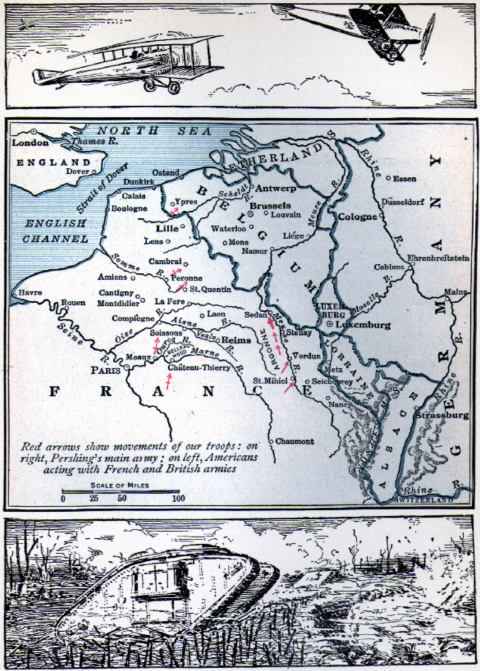Resource Center OLLibrary
|
428 |
|
[1918 |
Where our Men fought in the Great War
(see Map opposite). The first highly important battle we took
part in (July, 1918) was fought to save Paris. The Germans had
reached the ancient town of Château-Thierry on the River
Marne. They had crossed the river and were only forty miles from
the capital of France.
The French force was far larger than ours, yet
we had more than twice as many men as the Union army had at the
battle of Gettysburg (§ 343)
The combined French and American forces drove
the Germans back. They retreated slowly, fighting all the time,
but were gradually pushed farther and farther away, and Paris was
saved.
In September General Pershing moved forward with
an "all-American army," to which he joined a limited French force.
Our men won a sweeping victory which cleared the Germans out of
the town of St. Mihiel on the River Meuse.
We captured that place in order to open the way
along the banks of the Meuse to the strongly fortified city. of
Verdun on that river. Northwest of that city we attacked the enemy
and smashed through his first line, twenty miles in width.
The Crown Prince, the eldest son of the Kaiser,
had long been pounding at the Verdun forts. He boasted that his
armies would make Verdun their gateway to the heart of France. But
the sturdy French patriots who defended the city shouted, "They
shall not pass!" and the Germans who tried to jam through found
that it was not a gateway, but a graveyard.
Pershing's American army continued to advance
northward along the banks of the Meuse and through that part of
France called the Argonne. It is a region nearly as big as the
state of Rhode Island. The eastern side of it has rocky hills a
thousand feet high, and on the west there are miles of dense
forests in which it is difficult to move about. The Germans had
planted nests of machine guns among the trees and surrounded them
with barbed-wire entanglements which they defied the "Yanks" to
get through.
But our boys clambered up the hills, picked
their way through the thick woods, and broke down the
entanglements. They went on fighting desperately in this manner
not simply for days but for weeks. Finally they "squeezed out" the
last German. It was a wonderful piece of work.
When the ugly job was over, Pershing's army
started along the banks of the Meuse again, on its last great
expedition -- that was, to recover the French city of Sedan, which
had fallen into German hands.
The enemy was determined not to give it up,
because a railway from the German city of Metz ran through it,
bringing immense supplies of food and ammunition for his army. On
November 6-7, 1918, we drove the Germans out and cut off all these
supplies.
During the whole of this time -- from July to
November -- British, French, and American troops had been busy
farther west, hammering, pushing, and driving the enemy day and
night. The Germans saw that the end was coming. The victory at
Sedan marked that end, and a few days later, November 11, they
surrendered.
Nearly a year afterward (September, 1919) the
French Commander in Chief bade General Pershing farewell. He spoke
with deep feeling of what the American army -- living or dead --
had done for France. Clasping the General's hand he said, "We
shall never forget their deeds or their graves."

WHERE OUR
MEN FOUGHT IN THE
GREAT WAR
Château-Thierry (shah-toe'tee-er'y). Marne (marn). St.
Mihiel (san me-yel'). Meuse (muze).
Verdun (ver-dun'). Argonne (ar-gon'). Sedan (se-dan'). Metz
(mets).



